April itinerary in Japan Day 1 (Kochi Prefecture Meal edition)
(Monday, April 18)
Table of contents
1. Hirome Market Chinmi-do
I had to wait for about 2 hours for the limited express train from Kochi Station to Tosakure Station, so I had breakfast at “Chinmi-do” in “Hirome Market“. “Hirome Market” is open from 10 am to 10 pm, so it is a very convenient market for tourists.
“Chinmi-do” is the largest store in “Hirome Market”. They have so many seafood and food of the mountains that are unique to Kochi that we can’t imagine them in the market. I ate “Noresore”, “Dorome (raw whitebait)”, “Crab innards”, “Whale sinewy meat”, “Grilled mackerel sushi” and drank a sake “Senchu Hassaku”.

“Noresore” is a fry of conger eel (juvenile conger) and is a marine delicacy in Kochi prefecture. “Noresore” has a white and transparent body, and is also called a water fairy because of its mysterious appearance. The season for “Noresore” from Kochi prefecture is from February to May. In addition, “Noresore” is the name spread all over the country in Kochi prefecture. In other areas, it is called “Berata” in Okayama Prefecture, “Hanatale” in Hyogo Prefecture (Awaji Island and Akashi City), and “Peropero” in Ibaraki Prefecture. These names were introduced in the BLOG of “March itinerary in Japan Day 4 (Hiroshima, Okayama Meal ed.)” on April 23. It was good to be able to eat “Noresore” in the home of Kochi prefecture.

Japan Fisheries Co-operative has selected Kochi Haruno’s “Dorome” (season: September-December) as the autumn “PRIDE FISH” in Kochi Prefecture. In Kochi prefecture, raw whitebait (fry of anchovy) is called “drome”. “Dorome” is landed at the Haruno Fishing Port located at the western end of Kochi City. The fishing grounds are from the lower Niyodo River to the coast of Katsurahama. In “PRIDE FISH”, the season is autumn, but the fishing season is spring and autumn. It may not be the best season this time, but since it is spring in the fishing season, I was able to eat fresh and delicious dorome.
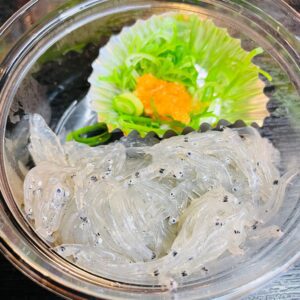
In Kochi prefecture, whale fishing has been flourishing alongside bonito for a long time. Currently, the catch whales is limited, so it is not possible to catch whales off the coast of Kochi, and minke whales from the Southern Ocean research whaling are used for whale dishes. In Kochi prefecture, various whale dishes are still eaten as a traditional food culture. I think that “Whale sinewy meat”, which uses whale sinewy meat, is a food unique to Kochi prefecture, which has whale as a food culture. It was a very delicious delicacy with a unique texture.
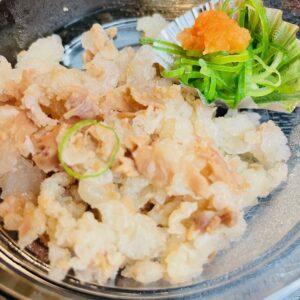
In Kochi prefecture, mackerel dishes are famous due to the existence of branded mackerel such as “Tosa-shimizu mackerel” which is also selected as “PRIDE FISH”. Ekiben “Grilled mackerel sushi” is a popular ekiben that was selected for the Bronze Award (2012, 2013) at the “Shikoku Ekiben Championship” sponsored by JR Shikoku. I don’t know if the “Grilled mackerel sushi” I ate at “Chinmi-do” was from Tosa Shimizu, but it was delicious “Grilled mackerel sushi”.
2. Craft beer TOSACO
I drank two bottles of Kochi Campagne Brewery‘s craft beer “TOSACO” on the limited express train “Ashizuri No. 3” from Kochi Station to Tosa-Kure Station.
Kochi Campagne Brewery is a young beer company founded in 2017, but it is an up-and-coming beer company that has won numerous awards. They mainly use materials from Kochi prefecture and manufacture craft beer in Tosayamada-cho, Kami city, Kochi prefecture. The package design of the beer bottle is also very good, and it is a beer company that has a good impression.
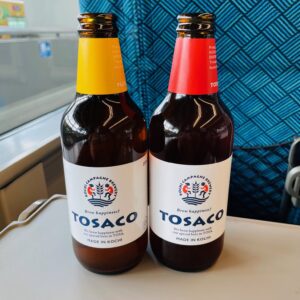
This time I drank “Yuzu Pale Ale” and “Tosa IPA”. “Yuzu Pale Ale” was a refreshing and delicious beer with the aroma and taste of Yuzu. On the other hand, “Tosa IPA” was a beer with a solid taste unique to IPA. The trip was very good while enjoying the beautiful scenery of Kochi prefecture and drinking the delicious craft beer “TOSACO” from Kochi prefecture.
3. Tanaka Fresh Fish Store
I arrived at Tosakure Station and had lunch at the “Tanaka Fresh Fish Store” in the Kure Taishomachi Ichiba Market. Kure Taishomachi Ichiba Market is the most lively place in the city of Kure. The market sells many ingredients such as fresh fish and shellfish, dried fish, and locally grown vegetables. The origin of the name “Taisho” in the Kure Taishomachi Ichiba market is that the Emperor Taisho donated reconstruction expenses when the area around the market was destroyed by fire in 1915 (Taisho 4).
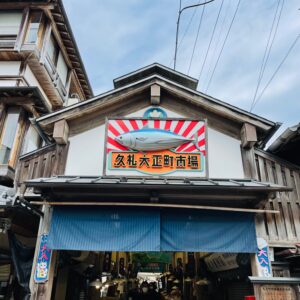
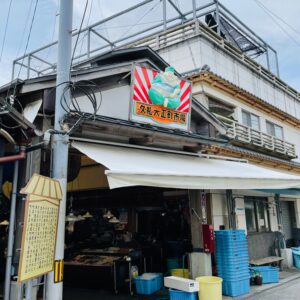
The “Tanaka Fresh Fish Store” sells fresh fish and shellfish, and we can eat the fish and shellfish purchased there at the “Fisherman’s Hut”. The “Fisherman’s hut” was full and waited for about 5 minutes for seats to become available. A huge fish basket is hanging at the storefront of “Tanaka Fresh Fish Store”.
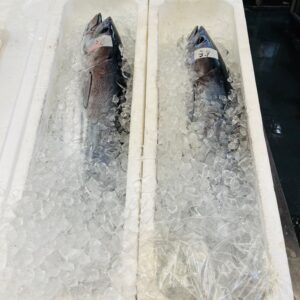
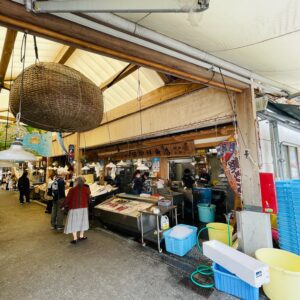
I ate “bonito sashimi”, “bonito tataki (lightly roasted bonito)”, “moray eel tataki (lightly roasted moray eel)” and “Dorome”. “Dorome” was Yen 300, which is half the price of “Chinmi-do”. It is truly a fisherman’s town. A set of rice and miso soup is Yen 300.
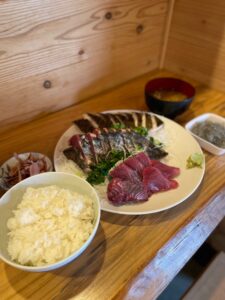
“bonito sashimi”, “bonito tataki (lightly roasted bonito)” were the best tastes in my life. It was a delicious bonito with a sticky texture peculiar to bonito. There was no odor. It takes less than an hour by express train from Kochi station, but I think the “fisherman’s hut” is a restaurant worth the trip. In addition, “Fisherman’s hut” got a high score of 3.67 in Tabelog, and is ranked 15th in all restaurants in Kochi prefecture.
“Katsuo no tataki (lightly roasted bonito)” has been selected as one of the “100 Best Local Cuisine” in Kochi Prefecture by the Ministry of Agriculture, Forestry and Fisheries.
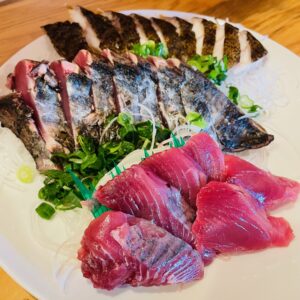
Japan Fisheries Co-operative has selected “Tosa Saga no Himodori Bonito (Bonito with outstanding freshness caught by Tosa Saga)” (season: March-May) as the “PRIDE FISH” in the spring of Kochi Prefecture. “Tosa Saga no Himodori Bonito” is a bonito with outstanding freshness that you can eat the bonito landed on the same day that you caught by “Ippon fishing (pole‐and‐line fishing)” at Tosa Saga in Kuroshio-cho, Hata-gun.
Kochi Prefecture is the number one bonito consuming prefecture in Japan, and the per capita consumption is about five times the national average. It consumes more than twice as much as Fukushima Prefecture, which ranks second. However, the catch is 4th in Japan and the share is 6% (2020). The small catch in Kochi prefecture is quite surprising. The first place is Shizuoka prefecture (30% share), the second place is Tokyo (18% share), and the third place is Miyagi prefecture (11% share).
“Moray eel tataki” is a specialty of Kochi prefecture. Moray eels live everywhere in the waters near Japan where the Kuroshio Current passes. However, the areas that use moray eels as ingredients are mainly limited to some areas such as Shikoku (Kochi, Ehime, Kagawa, Tokushima) and Wakayama prefecture. Moray eels have thick skins and fine bones, which makes it difficult to cook, which is why they are difficult to use in other areas. However, the taste is delicious. “Moray eel tataki” is a cooking method that can be eaten mainly in Kochi prefecture. The “moray eel tataki” was also delicious, but the impression was less than that of the bonito. Because I was so impressed by the bonito this time.
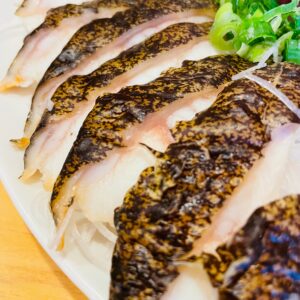
I ate a skewer of “bonito heart (chichiko)” (Yen 200 per skewer) at “Kushiyaki Ponkichi” at the “Tanaka Fresh Fish Store”. Naturally, only one heart can be taken from one bonito. Therefore, the bonito heart is an extremely valuable part. Also, since it is difficult to keep the freshness, it seems that you can basically eat it only near the fishing port where bonito is fished. The picture below was taken after eating two “bonito hearts”. At first, there were 4 of them. I felt the taste was close to that of beef liver. It was just a delicacy. Keiji Kudo, the owner of “Kushiyaki Ponkichi”, was a nice person who explained various things about bonito.

4. Okamura Kamaboko store
After enjoying a walk in the city of Kure, I ate “Kureten” at the Okamura Kamaboko store. “Kureten” is a traditional taste of Tosa-Kure and has been in business since 1938. Even if they make 2,000 sheets every day, they may sell out. The fish used for Kureten are fresh small fish caught locally. Small fish are mashed together with their bones, thoroughly kneaded, and then fried in oil.
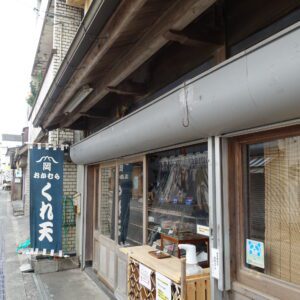
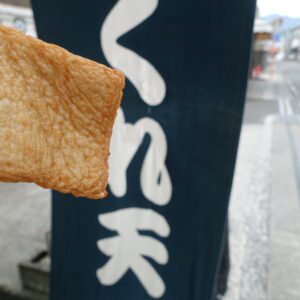
“Kureten” at Okamura Kamaboko store sells one piece (Yen 80). It was one of the most delicious deep-fried kamaboko (Satsuma-age, Obiten, etc.) I have ever eaten. This is a shop that you definitely want to stop by when you go to the town of Kure.
5. Izakaya Kihachi
I moved from Tosakure station to Nakamura station, and after a little sightseeing, I had dinner at “Izakaya Kihachi”. I entered the store at 6 pm, but it was already quite crowded and was full at 6:30 pm. Despite Monday night, it’s a hugely popular restaurant. In fact, they got a high score of 3.68 in Tabelog and was 11th in Kochi prefecture as a whole.
I ordered “Shimizu mackerel sashimi”, “bonito salt tataki”, “horse mackerel sashimi”, “eel shiroyaki (unglazed pottery)”, and “fried young Dusky tripletooth goby” at “Izakaya Kihachi”.
“Mackerel in Tosa-shimizu” (season: October-February) has been selected as a winter “PRIDE FISH” in Kochi Prefecture by the National Federation of Fisheries Cooperatives. Off the coast of Ashizuri-misaki in Tosa-shimizu City, Kochi Prefecture, the tidal current is fast and the food is abundant, so tight-fitting mackerel is caught all year round. Because each fish is fished one by one, it is landed in the best condition without damaging the net.
It was a little past the season in mid-April, but it was a delicious mackerel that melted. At “Izakaya Kihachi,” it was recommended not only to eat mackerel sashimi in regular sashimi soy sauce, but also to eat it in garlic slices and ponzu sauce, just like bonito. I was able to eat the same mackerel sashimi as deliciously as a different dish, because I changed the way I eat it.

“Salt bonito tataki” was an excellent salt tataki made from bonito caught at Shimizu Port. The bonito tataki I ate at “Tanaka Fresh Fish Store” was one of the best in my history, but the “bonito salt tataki” at “Izakaya Kihachi” was as delicious as it was.

I was not impressed with “horse mackerel sashimi”, because “Shimizu mackerel sashimi” and “bonito salt tataki” were so exquisite. However, the “sashimi of horse mackerel” was also delicious enough.

Both “eel shiroyaki (unglazed pottery)” and “fried young Dusky tripletooth goby” are Shimanto River specialties. “eel shiroyaki” was a little small eel, but it was very soft and delicious. I would like to explain the details of the Shimanto River’s natural eel in the BLOG that will be posted four days later.

“Gori” is a young Dusky tripletooth goby, a member of the goby. The fishing season for “Gori” is from February to April, so I was able to eat “fried Gori” just in season. It was a delicious fried Gori that was small and easy to eat. “fried Gori” tasted good with both beer and sake.

Note: The departure / arrival times, fares of transportation, admission fees, meal fees, etc. listed in the text are as of the time of writing the BLOG. Please check for yourself when you go on a trip as it may change in the future.
